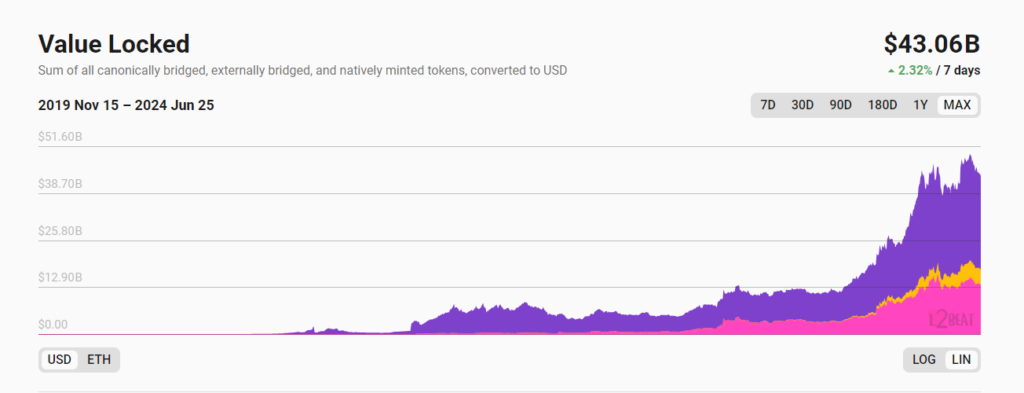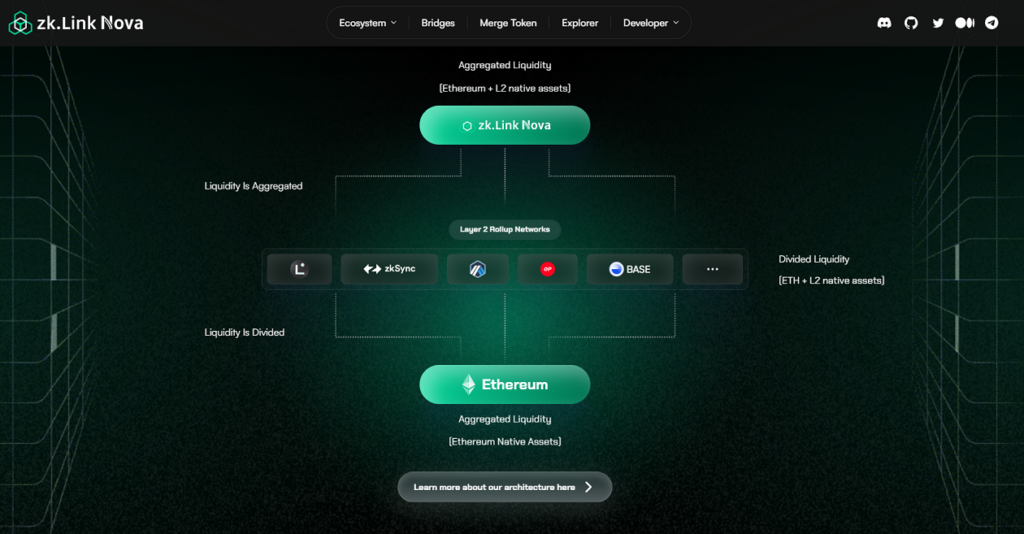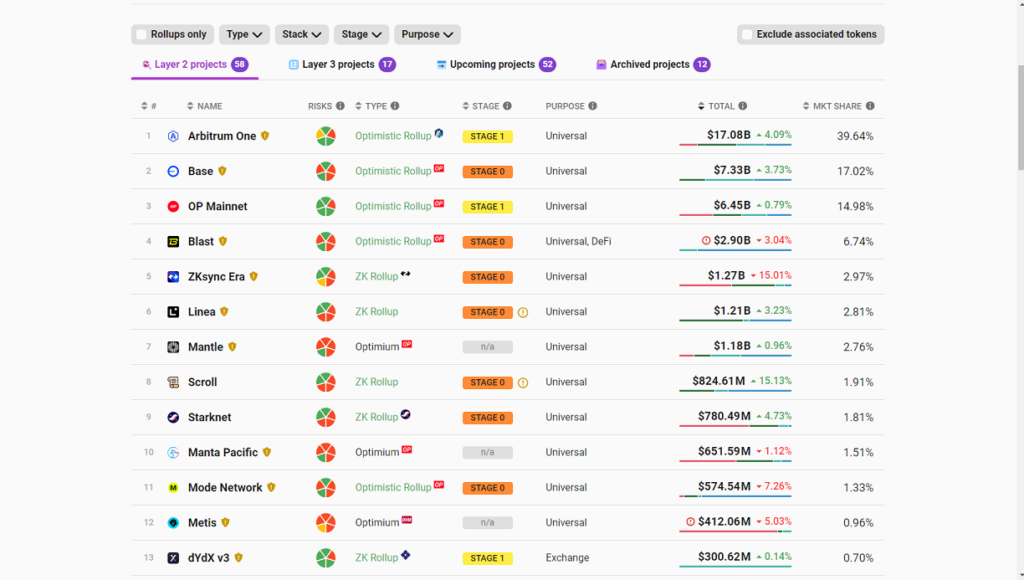According to several layer-2 rollup teams, including those for Linea, zkSync, Arbitrum, and Optimism, complete decentralization is imminent.
Decentralization has not progressed as planned for several reasons, including enhancing security and user experience. However, the teams asserted that “Stage 2” will be reached shortly and that progress is currently being made in decentralizing these networks.
The term “Stage 2 decentralization” describes the last phase of layer-2 decentralization milestones as listed by Ethereum founder Vitalik Buterin. Because it would potentially make network censorship impossible, it is also known as “full decentralization.”
Ethereum layer two networks compress and validate Ethereum transactions across several networks to increase Ethereum’s scalability.
Some networks claim that decentralization will arrive shortly.
Users should anticipate that most L2s will have reached Stage 2 of decentralization “within the next few years,” according to Linea founder Nicolas Liochon.
According to Liochon, “rollups prioritized other significant upgrades that directly impact the user experience and security.” “The Dencun upgrade, for instance, has significantly reduced user costs.”
However, now that these improvements have been implemented, getting to Stage 2 “has started.” Liochon states that “in the coming months,” the team will launch a testnet with further decentralization features.
Matter Labs, the company behind zkSync, expects its dominant L2s to reach Stage 2 “over the next two to three years,” according to Anthony Rose, chief technology officer.
Rose anticipates some space consolidation. At present, over 20 L2s have a total value locked (TVL) of at least $100 million. However, “we will see a relatively small number of extensive networks” in the future. These networks consist of several chains, the biggest of which will be fully decentralized.
Rose says, “The performance of these systems can take advantage of certain things.” “Therefore, during the next two to three years, the major ones currently in stage two will get rid of their training wheels.”

Karl Floersch, a co-founder of Optimism, said that the transition to Stage 2 will be “swift and decisive.” Reaching Stage 2, in his opinion, is challenging since it necessitates several proof implementations, which he describes as “the most security-critical code and [require] unbelievable levels of assurance.” Nevertheless, he anticipates that his network will soon accomplish this goal.
Furthermore, according to Floersch, others will do likewise swiftly once one network hits Stage 2. This is as a result of blockchain development’s open-source nature:
“Once we get to Stage 2, a majority of L2s will get there too. That’s part of the beauty of building out open source ecosystems: the value driven by contributions can be shared by all the participants and projects who are using the standards.”
Offchain Labs, the company that develops Arbitrum, said its network is “very, very close” to achieving Stage 2. Steven Goldfedder is one of the team’s co-founders. The only way to overcome Arbitrum’s fraud proofs is for its security council to vote nine times out of twelve. The holders of ARB tokens choose the council.
“I believe that two of them are our team members,” Goldfedder said. “So, our group can’t even veto.”
To proceed to Stage 2, Arbitrum would have to take away the security council’s authority to act, except in situations where there are “provable bugs.” Goldfedder states this is “more of a question of community readiness than anything else.” Voting for this amendment would be required of ARB token holders who still need to do so.
Goldfeder claims that although the Arbitrum Security Council has the authority to do so, it has never taken any action to nullify fraud proofs. That said, if the Arbitrum decentralized autonomous organization desires to eliminate this emergency power, it can vote to eliminate it, which would be “the last hurdle” to advance the network to Stage 2.
The CEO of layer-3 network zkLink, Vince Yang, also calculated that. According to Yang, a large portion of the problem is due to users’ disinterest. He said, “The industry’s demand for further decentralization is relatively low, as L2/L3s already inherit the security from Ethereum.”
Some networks assert that decentralization is far off.
Although several networks mentioned above expressed optimism that complete decentralization would happen soon, others claimed this ideological goal is still far from becoming a reality.
Kevin Liu, a co-founder of Metis, claims that because most L2s rely on token-voting systems for governance, they are challenging to decentralize. According to Liu, “traditional token voting frequently results in concentrated control by large token holders.”
Protocols must decentralize their sequencers to guarantee that “all participating nodes and stakeholders from the economy layer on the network.” Because “each sequencer node earns mining rewards based on the blocks they produce, and all on-chain activities benefit the nodes themselves,” Liu stated that Metis uses this form of governance.
Still, Metis is not entirely decentralized, and L2s remain a long way from reaching this objective. He said, “Given the current state of the technology and the ongoing need for upgrades, I don’t believe pure decentralization for layer-2 solutions is achievable shortly from a technical standpoint.”
Liu said that despite the challenges and length of the road ahead, teams should keep pursuing the goal of decentralization. He said:
“Decentralization is not just one technical layer, which is still not mature; decentralization is multilayer, and we believe our approach is the most practical one and will drive the progress of technical upgrades as well.”
The CEO of the layer-3 network zkLink, Vince Yang, issued a similar word of caution regarding the timeline for decentralization. According to Yang, a large portion of the problem is due to users’ disinterest. He said, “The industry’s demand for further decentralization is relatively low, as L2/L3s already inherit the security from Ethereum.”
Furthermore, persuading L2 decentralized autonomous organizations to share their wealth with independent players is challenging since they may want to keep their monopoly on income. “L2/L3 networks have a financial incentive to maximize revenue on transactions, which further discourages behavior and attitude toward complete decentralization,” the speaker asserted.

Yang claims that the layer-2 Linea serves as a settlement layer for kink. Because it saves compressed transaction data with a data availability committee (DAC) rather than directly on the settlement layer, it is a “valium” as opposed to a full rollup.
According to him, the zkLink team plans to further the decentralization of the Celestia network by storing compressed data there in the future.
The phases involved in decentralization
The post “Proposed milestones for rollups taking off training wheels” by Buterin from November 2022 is where the idea of “stages” of decentralization originated. According to Buterin’s essay, layer-2 rollups could begin with centralized control as temporary “training wheels,” provided they gradually move toward decentralization.
Buterin distinguished three decentralization phases. A network must include software that may be used to independently calculate the rollup’s state for it to be referred to as a “Stage 0 rollup.” The development team can still restrict transactions or prevent withdrawals by publishing fake state origins on Ethereum.
The network’s Ethereum smart contracts must include fraud or validity proofs to be called a “Stage 1 rollup.” As a result, the sequencer for the team is no longer able to publish bogus state roots because they would be deemed invalid.
Nonetheless, security councils with the authority to overrule legitimate transactions are permitted in Stage 1 networks. The council must take explicit action to carry out an override, and it can only do so with six of its eight votes. The council needs at least two members who are off the development team.
The security council cannot override the network’s fraud proofs in a Stage 2 rollup unless they conflict with one another or the network hasn’t executed a transaction in at least seven days.
L2Beat, a blockchain analytics platform, classifies L2 networks according to Buterin’s criteria and frequently assesses them.

In June, the absence of decentralization in the majority of layer 2s caused controversy when the Linea team could halt withdrawals and censor one user’s address successfully. An attacker who had taken advantage of the Volocore decentralized exchange was censored. Although several users expressed happiness at the attacker’s withdrawals being stopped, others contended that this demonstrated that layer 2s were taking too long to decentralize.
Buterin has stated that rollups should advance to Stage 1 by the end of 2024 or cease to exist altogether.



